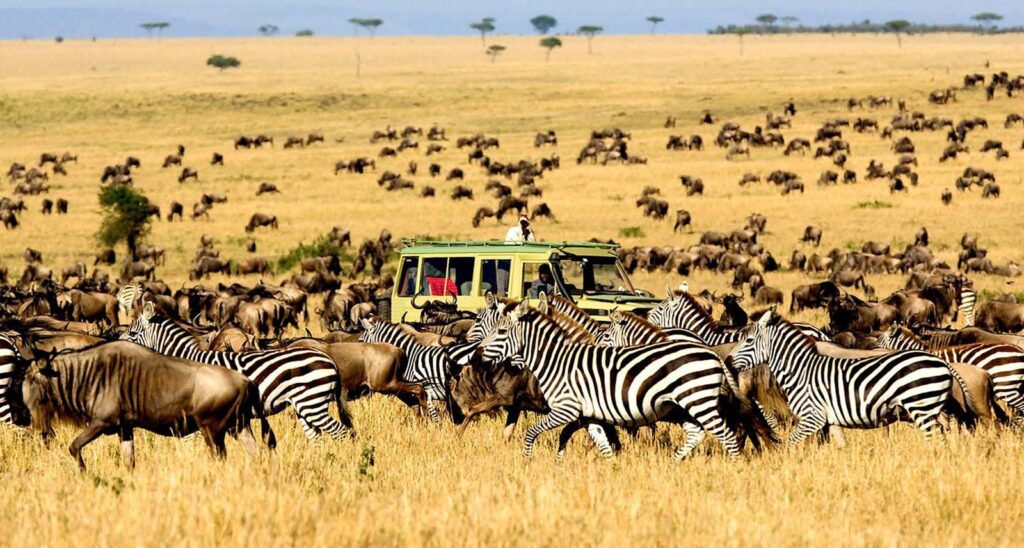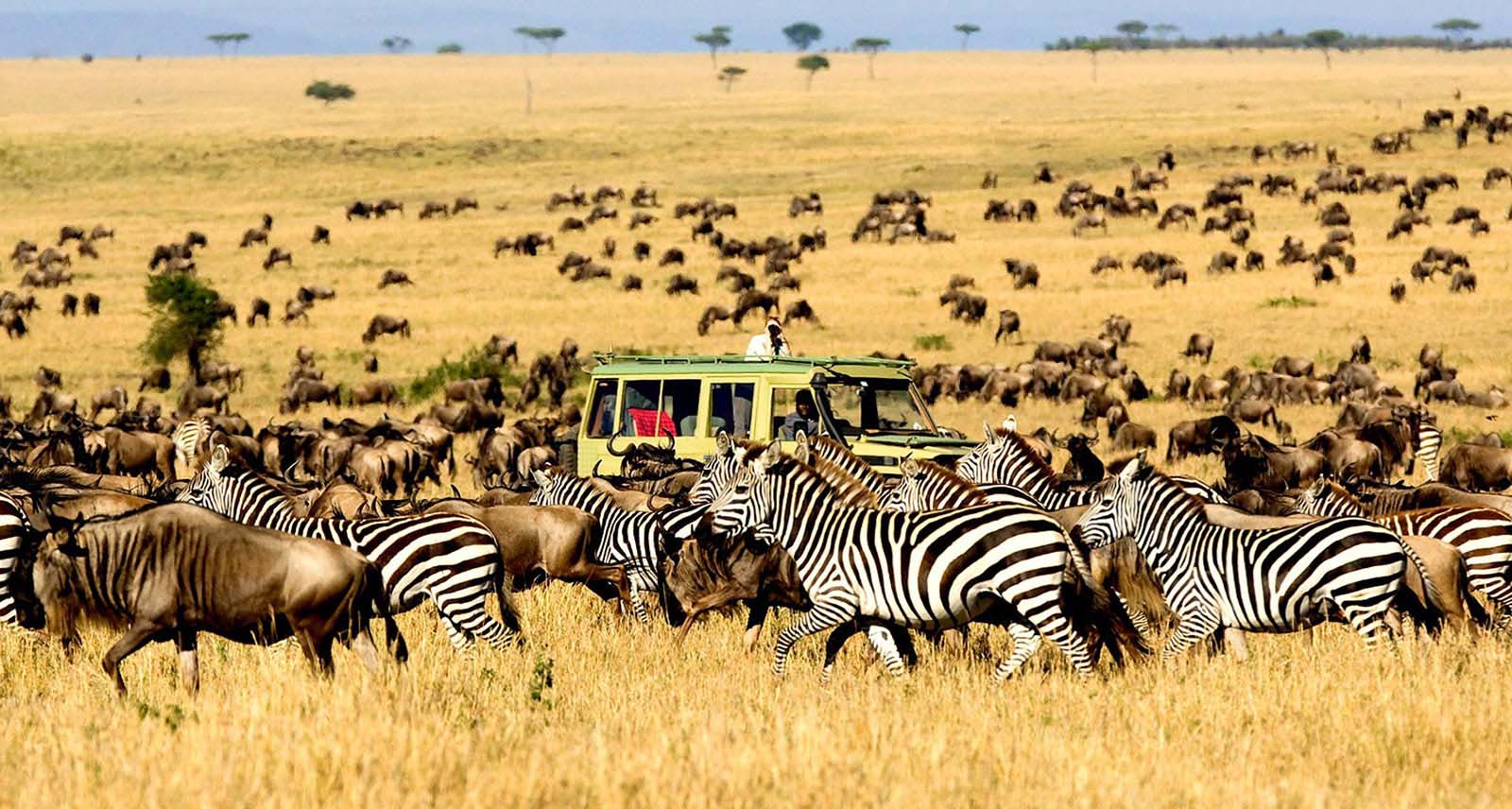
The Ndutu region of Tanzania offers an unforgettable experience for anyone looking to immerse themselves in wild beauty and culture.
You will witness the stunning spectacle of the Great Migration, where thousands of wildebeest make their journey across the Serengeti, creating a dynamic landscape filled with life.
This area is not only a prime location for observing diverse wildlife, but it also boasts unique photographic opportunities that capture the essence of nature.
In addition to its rich wildlife, Ndutu is steeped in the native Maasai culture, allowing you to connect with the traditions and ways of life of the local people.
This blend of exhilarating experiences makes Ndutu a must-visit destination for adventure seekers and nature lovers alike.
Whether you’re hoping to encounter the “Big Five” or learn about conservation efforts, Ndutu has something for everyone.
Key Takeaways
- Experience the incredible Great Migration firsthand.
- Enjoy unique photographic moments in stunning landscapes.
- Engage with the vibrant Maasai culture and conservation efforts.
Wildlife Migration Spectacle
The Ndutu region offers a remarkable view of wildlife migration, especially during the calving season.
You can witness thousands of wildebeest and a rich array of predators in action. This experience highlights the natural rhythms of life in the African savannah.
The Great Wildebeest Calving
During the calving season, which typically occurs from January to March, the plains of Ndutu come alive. Around 500,000 wildebeest gather to give birth, creating a vibrant spectacle.
You’ll see newborn calves taking their first steps within hours of birth. This timing maximizes survival chances, as the nutrient-rich grass is abundant.
Observing this event is remarkable, not just for its beauty but also for the raw display of nature. The mothers are fiercely protective, while predators like lions and hyenas are always on the prowl, looking for an easy meal.
Diverse Predator Presence
The diverse predator presence adds excitement to your Ndutu experience. Major predators include lions, cheetahs, and hyenas.
You may witness a lioness hunting, or a cheetah sprinting after its prey. This dynamic creates a thrilling atmosphere, as you can see the balance of life and death in the wild.
The Ndutu region is unique because it allows off-road driving. This means you can get close to the action without disturbing the wildlife.
This proximity increases your chances of spotting these majestic hunters at work and deepens your understanding of the intricate predator-prey relationships that unfold daily in this spectacular ecosystem.
Photographic Opportunities
Ndutu provides stunning landscapes and unique wildlife interactions, making it a prime location for photography. You can capture incredible moments in various lighting conditions and settings.
Serengeti’s Golden Light
One of the standout features of the Ndutu region is the captivating golden light during sunrise and sunset. This soft, warm light enhances the colors of the landscape and the animals, creating perfect conditions for striking photographs.
Early mornings are ideal, as you can catch the mist rising over the plains. The light casts long shadows, adding depth to your images. As the sun sets, the sky transforms into a palette of orange and pink hues, creating a memorable backdrop for your shots.
Wildlife is abundant here, making for dynamic compositions. You can photograph herds of wildebeest and zebra against the stunning landscapes, all illuminated by that perfect golden glow.
Professional Photography Tours
You can enhance your photography experience by joining professional photography tours offered in the Ndutu region. These tours are designed for both amateurs and experts, providing guidance on the best techniques and locations.
A professional guide can help you find unique angles and teach you how to work with natural light.
Many tours also let you drive off-road, allowing you to get closer to animals without restrictions. This access is a key advantage for capturing striking wildlife images.
Tours often include workshops focusing on techniques like composition, exposure settings, and post-processing tips. By participating, you’ll not only capture beautiful images but also improve your skills alongside other photography enthusiasts.
Native Maasai Culture
The Maasai people are an iconic part of Tanzania’s cultural landscape. When you visit the Ndutu region, you have the chance to experience their rich traditions and lifestyle.
You can engage with the Maasai communities through various activities. Here are a few experiences you might enjoy:
- Cultural Tours: Explore traditional villages and learn about daily life.
- Dance Performances: Watch vibrant dances that tell stories of their heritage.
- Craft Markets: Purchase handmade jewelry and crafts that reflect Maasai artistry.
The Maasai are known for their unique customs. They practice cattle herding, which is central to their culture. Cattle are not just livestock; they play a crucial role in their social structure.
Their dress is also notable, featuring bright shúkà cloth, which symbolizes their identity. You may get the opportunity to dress in traditional attire during your visit.
Respect for the land and wildlife is important to the Maasai. They have deep knowledge of the local ecosystem, which enhances wildlife conservation efforts.
As you interact with local guides, you can learn about the Maasai’s beliefs and values. This insight enriches your understanding of the region and adds depth to your travel experience.
Visiting Ndutu gives you a chance to connect with this vibrant culture while enjoying the stunning natural beauty Tanzania has to offer.
Conservation Efforts
The Ndutu region is vital for wildlife conservation in Tanzania. It is part of the Ngorongoro Conservation Area, which emphasizes the protection of animal habitats.
You will find several key conservation initiatives aimed at preserving the area’s unique ecosystems. These programs include anti-poaching efforts and habitat restoration projects. Engaging local communities also plays a big role in conservation success.
Key Conservation Initiatives:
- Anti-Poaching Patrols: Rangers work tirelessly to protect wildlife from poachers, ensuring safety for animals like elephants and rhinos.
- Community Involvement: Local communities are educated about the importance of wildlife preservation. This helps foster sustainable practices and reduce human-wildlife conflict.
- Research and Monitoring: Scientists conduct studies on animal behavior and habitat health. This data guides conservation strategies to protect endangered species.
By visiting Ndutu, you support these efforts directly. Your tourism dollars contribute to conservation projects and help maintain the delicate balance of this ecosystem.
Participating in guided tours led by knowledgeable guides can deepen your understanding of conservation in action. Each visit helps create a future where wildlife and humans can thrive together.
Frequently Asked Questions
When planning your visit to the Ndutu region, you might have some questions. Below are answers covering wildlife viewing, accommodations, transportation, and the best times to visit.
What are the wildlife viewing opportunities in the Ndutu region?
Ndutu is famous for its diverse wildlife. You can see large herds of wildebeest, zebras, and various antelopes, especially during the great migration. Predators like lions and hyenas also roam the area, making it a prime spot for wildlife enthusiasts.
How does the Ndutu region differ from other parts of the Serengeti during migration season?
During migration season, Ndutu becomes a calving ground for wildebeest. The nutrient-rich grasses support newborns and their mothers. This area sees a high concentration of wildlife, which is less common in other parts of the Serengeti during this time.
What types of accommodation are available for tourists in Ndutu?
You can find a variety of accommodations in Ndutu, ranging from luxury lodges to more basic tented camps. Many lodges offer great views of the surrounding landscape and easy access to wildlife viewing. This allows you to choose an option that fits your budget and preferences.
Can you describe the best times of year for visiting the Ndutu area?
The best time to visit Ndutu is from late December to March. This period coincides with the great migration, where you can observe numerous animals calving. Visiting during this time increases your chances of seeing dramatic wildlife action.
What activities can visitors engage in while staying in the Ndutu region?
You can enjoy various activities in Ndutu, including game drives, guided walks, and bird watching. Many lodges also offer cultural experiences, allowing you to engage with local communities. These activities enhance your overall experience in this unique area.
How do I get to the Ndutu region and what are the transportation options?
To reach Ndutu, you can fly into Kilimanjaro International Airport and then take a small charter flight to nearby airstrips.
Alternatively, you can drive from Arusha, which might take several hours.
Local operators often provide transport services to help you get around the area.

Leave a Reply